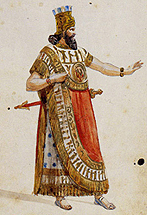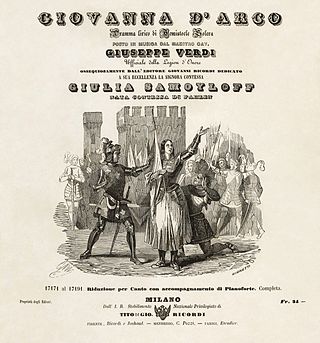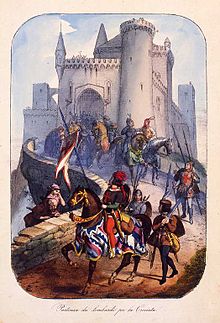
Giuseppe Fortunino Francesco Verdi was an Italian composer best known for his operas. He was born near Busseto to a provincial family of moderate means, receiving a musical education with the help of a local patron. Verdi came to dominate the Italian opera scene after the era of Gioachino Rossini, Vincenzo Bellini, and Gaetano Donizetti, whose works significantly influenced him.

Ernani is an operatic dramma lirico in four acts by Giuseppe Verdi to an Italian libretto by Francesco Maria Piave, based on the 1830 play Hernani by Victor Hugo.

Un ballo in maschera is an 1859 opera in three acts by Giuseppe Verdi. The text, by Antonio Somma, was based on Eugène Scribe's libretto for Daniel Auber's 1833 five act opera, Gustave III, ou Le bal masqué.

Nabucco is an Italian-language opera in four acts composed in 1841 by Giuseppe Verdi to an Italian libretto by Temistocle Solera. The libretto is based on the biblical books of 2 Kings, Jeremiah, Lamentations, and Daniel, and on the 1836 play by Auguste Anicet-Bourgeois and Francis Cornu. However, Antonio Cortese's ballet adaptation of the play, given at La Scala in 1836, was a more important source for Solera than the play itself. Under its original name of Nabucodonosor, the opera was first performed at La Scala in Milan on 9 March 1842.

Macbeth is an opera in four acts by Giuseppe Verdi, with an Italian libretto by Francesco Maria Piave and additions by Andrea Maffei, based on William Shakespeare's play of the same name. Written for the Teatro della Pergola in Florence, it was Verdi's tenth opera and premiered on 14 March 1847. Macbeth was the first Shakespeare play that Verdi adapted for the operatic stage. Almost twenty years later, Macbeth was revised and expanded in a French version and given in Paris on 19 April 1865.

Clelia Maria Giuseppa (Giuseppina) Strepponi was a nineteenth-century Italian operatic soprano of great renown and the second wife of composer Giuseppe Verdi.

Oberto, Conte di San Bonifacio is an opera in two acts by Giuseppe Verdi to an Italian libretto by Temistocle Solera, based on an existing libretto by Antonio Piazza probably called Rocester.

I due Foscari is an opera in three acts by Giuseppe Verdi to an Italian libretto by Francesco Maria Piave, based on the 1821 historical play, The Two Foscari by Lord Byron.

I masnadieri is an opera in four acts by Giuseppe Verdi to an Italian libretto by Andrea Maffei, based on the play Die Räuber by Friedrich von Schiller. As Verdi became more successful in Italy, he began to receive offers from other opera houses outside the country. The London impresario Benjamin Lumley had presented Ernani in 1845 and, as a result of its success, commissioned an opera from the composer which became I masnadieri. It was given its first performance at Her Majesty's Theatre on 22 July 1847 with Verdi conducting the first two performances.

Aroldo is an opera in four acts by Giuseppe Verdi to an Italian libretto by Francesco Maria Piave, based on and adapted from their earlier 1850 collaboration, Stiffelio. The first performance was given in the Teatro Nuovo Comunale in Rimini on 16 August 1857.

Giovanna d'Arco is an operatic dramma lirico with a prologue and three acts by Giuseppe Verdi set to an Italian libretto by Temistocle Solera, who had prepared the libretti for Nabucco and I Lombardi. It is Verdi's seventh opera.

Attila is an opera in a prologue and three acts by Giuseppe Verdi to an Italian libretto by Temistocle Solera, based on the 1809 play Attila, König der Hunnen by Zacharias Werner. The opera received its first performance at La Fenice in Venice on 17 March 1846.

Ghena Dimitrova was a Bulgarian operatic soprano. Her voice was known for its power and extension used in operatic roles such as Turandot in a career spanning four decades.

Il corsaro is an opera in three acts by Giuseppe Verdi, from a libretto by Francesco Maria Piave, based on Lord Byron's 1814 poem The Corsair. The first performance was given at the Teatro Grande in Trieste on 25 October 1848.

La battaglia di Legnano is an opera in four acts, with music by Giuseppe Verdi to an Italian-language libretto by Salvadore Cammarano. It was based on the play La Bataille de Toulouse by Joseph Méry, later the co-librettist of Don Carlos.

Alzira is an opera in a prologue and two acts by Giuseppe Verdi to an Italian libretto by Salvatore Cammarano, based on the 1736 play Alzire, ou les Américains by Voltaire.

"Va, pensiero", also known as the "Chorus of the Hebrew Slaves", is a chorus from the opera Nabucco (1842) by Giuseppe Verdi. It recollects the period of Babylonian captivity after the loss of the First Temple in Jerusalem in 586 BCE.

Jérusalem is a grand opera in four acts by Giuseppe Verdi. The libretto was to be an adaptation and partial translation of the composer's original 1843 Italian opera, I Lombardi alla prima crociata. It was the one opera which he regarded as the most suitable for being translated into French and, taking Eugène Scribe's advice, Verdi agreed that a French libretto was to be prepared by Alphonse Royer and Gustave Vaëz, who had written the libretto for Donizetti's most successful French opera, La favorite. The opera received its premiere performance at the Salle Le Peletier in Paris on 26 November 1847. The maiden production was designed by Paul Lormier (costumes), Charles Séchan, Jules Diéterle and Édouard Desplechin, and Charles-Antoine Cambon and Joseph Thierry.

Angela Meade is an American operatic soprano.
In opera, a banda refers to a musical ensemble which is used in addition to the main orchestra and plays the music which is actually heard by the characters in the opera. A banda sul palco was prominently used in Rossini's Neapolitan operas. Verdi used the term banda to refer to a banda sul palco, as in the score for Rigoletto. He used the term banda interna, to refer to a band which is still separate from the orchestra but heard from the off-stage wings. The early scores of La traviata use a banda interna.


























